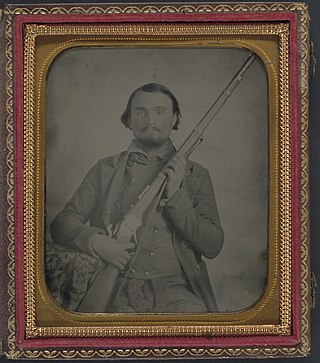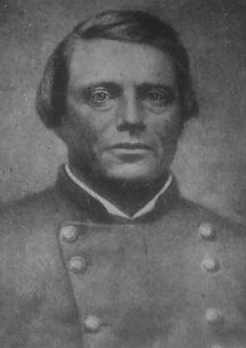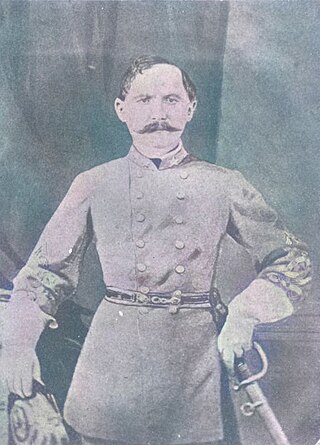
Texas declared its secession from the Union on February 1, 1861, and joined the Confederate States on March 2, 1861, after it had replaced its governor, Sam Houston, who had refused to take an oath of allegiance to the Confederacy. As with those of other states, the Declaration of Secession was not recognized by the US government at Washington, DC. Some Texan military units fought in the Civil War east of the Mississippi River, but Texas was more useful for supplying soldiers and horses for the Confederate Army. Texas' supply role lasted until mid-1863, when Union gunboats started to control the Mississippi River, which prevented large transfers of men, horses, or cattle. Some cotton was sold in Mexico, but most of the crop became useless because of the Union's naval blockade of Galveston, Houston, and other ports.

The 9th Texas Cavalry Regiment was a unit of mounted volunteers that fought in the Confederate States Army during the American Civil War. The regiment fought at Round Mountain and Bird Creek (Chusto-Talasah) in 1861, Pea Ridge, Siege of Corinth, Second Corinth, Hatchie's Bridge and the Holly Springs Raid in 1862, and in the Atlanta campaign, Franklin, and Murfreesboro in 1864. The unit fought dismounted at Second Corinth and Hatchie's Bridge before being remounted as cavalry for the remainder of the war. The regiment surrendered to Federal forces on 4 May 1865 and its remaining personnel were paroled.

The 10th Texas Infantry Regiment was a unit of Confederate States Army infantry volunteers organized in October 1861 that fought during the American Civil War. The regiment was captured in its first major action at Arkansas Post in January 1863. After being exchanged three months later, the 10th Texas was consolidated with two other regiments and assigned to Patrick Cleburne's division. Subsequently, the consolidated regiment fought at Chickamauga, Missionary Ridge, and Ringgold Gap in 1863. After becoming an independent regiment again, the 10th Texas fought in the Atlanta Campaign, and at Franklin and Nashville in 1864. After a second consolidation the troops fought at Averasborough and Bentonville in 1865. The regiment's soldiers surrendered to Federal forces on 26 April 1865.

The 6th Texas Cavalry Regiment was a unit of mounted volunteers that fought in the Confederate States Army during the American Civil War. The regiment fought at Chustenahlah in 1861. The following year the unit fought at Pea Ridge, First Corinth, Second Corinth, Hatchie's Bridge, and Holly Springs. The 6th Texas Cavalry participated in the fighting at Thompson's Station in 1863, the Atlanta campaign, and the Franklin–Nashville Campaign in 1864. The regiment formally surrendered to Union forces in May 1865 and its remaining soldiers were paroled.

The 10th Texas Cavalry Regiment was a unit of mounted volunteers in the Confederate States Army which fought during the American Civil War. The regiment mustered as cavalry in October 1861 but was dismounted in April 1862 and served as infantry for the rest of the war. The regiment was present at the Siege of Corinth, and fought at Richmond, Ky., Stones River, and Chickamauga in 1862–1863, in the Meridian and Atlanta campaigns and at Nashville in 1864, and at Spanish Fort and Fort Blakeley in 1865. The remaining 65 members of the regiment surrendered to Federal forces on 4 May 1865.

The 14th Texas Cavalry Regiment was a unit of mounted volunteers in the Confederate States Army that fought during the American Civil War. The regiment mustered as cavalry in the fall of 1861 but the soldiers were dismounted in March 1862 and served as infantry for the rest of the war. The regiment fought at the Siege of Corinth, and at Richmond, Ky., Stones River, and Chickamauga in 1862–1863. The unit fought in the Meridian and Atlanta campaigns and at Nashville in 1864, and at Spanish Fort and Fort Blakeley in 1865. The remaining 100 members of the regiment were paroled by Federal forces on 9 May 1865.

The 5th Texas Cavalry Regiment or 5th Texas Mounted Rifles was a unit of mounted volunteers from Texas that fought in the Confederate States Army during the American Civil War. The unit was organized at San Antonio in August 1861 for the purpose of invading New Mexico Territory. In 1862, the unit participated in the ultimately unsuccessful New Mexico Campaign. In 1863, the regiment fought at Galveston, Fort Bisland, Irish Bend, Second Donaldsonville, and Sterling's Plantation. In 1864, the unit was in action during the Red River Campaign. After being withdrawn to Texas, the regiment disbanded by June 1865.

The 4th Texas Cavalry Regiment was a unit of mounted volunteers from Texas that fought in the Confederate States Army during the American Civil War. The unit was organized in September 1861 with the aim of seizing New Mexico Territory. In 1862, the regiment served in the unsuccessful New Mexico Campaign. In 1863, it was in action at Galveston, Fort Bisland, Irish Bend, Second Donaldsonville, Kock's Plantation, Sterling's Plantation, and Bayou Bourbeux. In 1864, the regiment fought at Mansfield and Pleasant Hill in the Red River Campaign. The unit surrendered in May 1865.

The 26th Texas Cavalry Regiment was a unit of mounted volunteers from Texas that fought in the Confederate States Army during the American Civil War. The unit first organized in August 1861 as the 7th Texas Cavalry Battalion with seven companies for the purpose of patrolling the Texas Gulf Coast. In January 1862, three companies were added, and the unit was renamed the 26th Texas Cavalry Regiment. The original colonel resigned and was replaced by Xavier Debray, a Frenchman educated at Saint-Cyr military academy. Constant drilling gave the unit its reputation as one of the best disciplined in Texas. Until 1864, the regiment only fought minor skirmishes with Union landing parties. That year it fought at Mansfield and Pleasant Hill in the Red River Campaign. Instead of disbanding in May 1865, the regiment stayed intact and briefly guarded the city of Houston against marauders.

The 23rd Texas Cavalry Regiment was a unit of mounted volunteers from Texas that fought in the Confederate States Army during the American Civil War. The unit first organized in spring 1862, but did not complete its 10-company organization until October 1862. Before being added to the regiment, one company was captured at Fort Donelson and was part of a prisoner exchange. The regiment became part of a brigade led by Hamilton Bee that was headquartered at Brownsville, Texas, and guarded the Texas Gulf Coast. In 1864, the brigade transferred to Louisiana and fought at Mansfield, Pleasant Hill, and Blair's Landing in the Red River Campaign. The regiment was dismounted to serve as infantry in February 1865 and surrendered to Federal forces in May 1865.

The 22nd Texas Cavalry Regiment was a unit of mounted volunteers from Texas that fought in the Confederate States Army during the American Civil War. The regiment first began organizing in late 1861 and by July 1862, it moved to the Indian Territory. The unit fought at Newtonia and McGuire's Store in fall 1862 and was dismounted soon after. The regiment fought as infantry at Prairie Grove in December 1862. It traveled to Louisiana in March 1863 where it joined a brigade led by Camille de Polignac. In 1864 the regiment fought at Mansfield, Pleasant Hill, and Yellow Bayou during the Red River Campaign. In March 1865 the regiment marched to Texas where it disbanded in May.

The 20th Texas Cavalry Regiment was a unit of mounted volunteers from Texas that fought in the Confederate States Army during the American Civil War. The regiment formed in spring and summer 1862 and served in the Indian Territory and Arkansas for its entire career. In late 1862, it fought at McGuire's Store and Prairie Grove. The regiment fought at Honey Springs and Bayou Fourche in 1863. The unit was in action at Middle Boggy Depot, Prairie D'Ane, Poison Springs, Marks' Mills, and Cabin Creek in 1864. The regiment surrendered to the Union Army in June 1865.

The 19th Texas Cavalry Regiment was a unit of mounted volunteers from Texas that fought in the Confederate States Army during the American Civil War. The regiment mustered into Confederate service at the end of March 1862. It moved to Arkansas in fall 1862 and managed to avoid being dismounted as infantry, instead serving in William Parsons' cavalry brigade. The regiment fought at Cape Girardeau in 1863. The unit operated against Union supply lines and skirmished with Union forces in Arkansas and Louisiana. It arrived too late to take part in the main battles of the Red River campaign of 1864, but fought at Yellow Bayou. In 1865, the unit moved to Texas where it disbanded in May 1865.

The 2nd Texas Cavalry Regiment was a volunteer cavalry unit from Texas that fought in the Confederate Army during the American Civil War. The unit was organized in May 1861 as the 2nd Texas Mounted Rifles. In early 1862, the regiment took part in the unsuccessful New Mexico Campaign before retreating to Texas. In April 1862 the unit reorganized at Austin, Texas, as the 2nd Texas Cavalry. In January 1863, part of the regiment helped recapture Galveston while another part was captured at Arkansas Post. After moving to Louisiana, the unit fought at LaFourche Crossing, Second Donaldsonville, Kock's Plantation, Sterling's Plantation, and Bayou Bourbeux. It returned to Texas in winter 1863 and remained there until the surrender in June 1865.

The 1st Texas Cavalry Regiment was a unit of mounted volunteers from Texas that fought in the Confederate States Army during the American Civil War. It was first organized as a 10-company regiment by Colonel Henry Eustace McCulloch in April 1861 and named the 1st Texas Mounted Rifles. In early May 1861, the regiment secured the surrender of the small Federal garrison of San Antonio. Except from a skirmish with Native Americans in November 1861, the regiment took part in no more actions. In April 1862, the unit was reduced to five companies and renamed the 8th Texas Cavalry Battalion. On 2 May 1862, William Overall Yager's 3rd Texas Cavalry Battalion was consolidated with the 8th Cavalry Battalion to form a new 1st Texas Cavalry Regiment under Colonel Augustus Buchel, a German soldier of fortune who emigrated to Texas in 1845. The regiment served on the Texas Gulf Coast in 1863 but later transferred to Louisiana. In 1864, it fought at Mansfield, Pleasant Hill, and Yellow Bayou in the Red River Campaign. After Buchel was killed at Pleasant Hill, Yager led the regiment for the rest of the war. The unit was included in the 2 June 1865 surrender.

The 29th Texas Cavalry Regiment was a unit of mounted volunteers from Texas that fought in the Confederate States Army during the American Civil War. Newspaper publisher Charles DeMorse formed the regiment at Clarksville, Texas, in July 1862 and became its colonel. The unit defended north Texas against Native American raids until March 1863, when it was ordered to march to Indian Territory. In July 1863, the regiment fought at Honey Springs. In October 1863, Richard Montgomery Gano assumed command of the brigade, which was troubled by poor morale and desertions. Gano's brigade moved to Arkansas where it fought at Poison Spring in April 1864. The regiment participated in a successful raid at Cabin Creek later that year. In early 1865, the unit was dismounted and added to an infantry division known as Walker's Greyhounds. The division was ordered to march to Hempstead, Texas, where it arrived in April 1865 and disbanded soon afterward.

The 30th Texas Cavalry Regiment was a unit of mounted volunteers from Texas that fought in the Confederate States Army during the American Civil War. Attorney Edward J. Gurley organized the regiment at Waco, Texas, in August 1862 and elected its colonel. Most of the recruits came from Waco and environs. Many men enlisted to escape the shame of being swept up by the Confederate Conscription Act, while others preferred to join the cavalry rather than serve in the infantry. For a year, the regiment remained within the state, defending the Texas Gulf Coast. In August 1863, the unit was reassigned to Smith P. Bankhead's cavalry brigade and ordered to march to Indian Territory. Since the brigade suffered from bad morale and desertions, in October 1863 Richard Montgomery Gano was appointed the new brigade commander. In March 1864, the bulk of the regiment raided Roseville, Arkansas, where Federal supplies were destroyed. After returning to Indian Territory, the regiment helped destroy a Union wagon train at Cabin Creek. In March 1865, the unit successfully resisted an order to dismount and serve as infantry. In May 1865, the regiment disbanded at Wallace Prairie near Austin, Texas.

The 31st Texas Cavalry Regiment was a unit of mounted volunteers from Texas that fought in the Confederate States Army during the American Civil War. Trevezant C. Hawpe organized the regiment in early 1862 with recruits mostly from Dallas County, Texas, and surrounding areas. In June 1862, it marched to Arkansas where it joined a brigade led by Douglas H. Cooper. The unit fought at Newtonia and McGuire's Store in the autumn of 1862 and subsequently dismounted to serve as infantry. The regiment served at Prairie Grove in December 1862. It moved to Louisiana in February 1863 at which time Hawpe resigned. The unit helped defeat a Federal force at Stirling's Plantation in September 1863. The following month it joined a brigade led by Camille de Polignac. In 1864 the regiment fought at Mansfield, Pleasant Hill, and Yellow Bayou during the Red River Campaign. In March 1865 the regiment marched to Texas where it disbanded in May.

The 34th Texas Cavalry Regiment was a unit of mounted volunteers from Texas that fought in the Confederate States Army during the American Civil War. Almerine M. Alexander organized the regiment from north Texas recruits in the winter of 1861–1862. The unit marched to Indian Territory in May 1862 where it joined a brigade commanded by Douglas H. Cooper. The regiment fought at Newtonia and McGuire's Store in fall 1862 afterward was dismounted. The regiment served as infantry at Prairie Grove in December 1862. It received orders to transfer to Louisiana in April 1863. The regiment joined a brigade led by Camille de Polignac in July 1863. The following year, the unit fought at Mansfield, Pleasant Hill, and Yellow Bayou during the Red River Campaign. In March 1865 the regiment was assigned to the Texas Infantry Division. Soon after, it marched to Texas where it disbanded in May 1865.
The 36th Texas Cavalry Regiment was a unit of mounted volunteers from Texas that fought in the Confederate States Army during the American Civil War. The regiment was organized in March 1862 at Belton, Texas and surgeon Peter C. Woods was appointed to command it. The unit patrolled the Texas Gulf Coast and then spent the winter of 1862–1863 at Port Lavaca, Texas. It marched to Brownsville, Texas, in spring 1863 and later joined Hamilton P. Bee's brigade. This brigade transferred to Louisiana where it fought at Mansfield, Pleasant Hill, Blair's Landing, and Yellow Bayou during the Red River campaign in 1864. Afterward, the regiment traveled to Crockett, Texas, and then Galveston, where it was present when the men were paroled in June 1865.



















